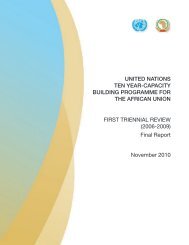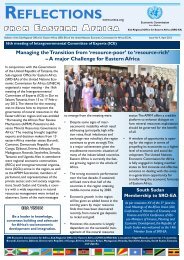A Decade of NEPAD - Economic Commission for Africa - uneca
A Decade of NEPAD - Economic Commission for Africa - uneca
A Decade of NEPAD - Economic Commission for Africa - uneca
Create successful ePaper yourself
Turn your PDF publications into a flip-book with our unique Google optimized e-Paper software.
implementation. US$6.9 billion is yet to be raised. The<br />
stage 1 and stage 2 studies and pilot projects are estimated<br />
to cost approximately US$70 million. A further US$51<br />
billion toward implementation was identified based on<br />
pre-feasibility estimates but not included within the AAP<br />
budgetary plan given the early stage nature <strong>of</strong> the projects.<br />
Given the recent experiences <strong>of</strong> accelerating donor support,<br />
notwithstanding the global financial crisis <strong>of</strong> the past two<br />
years, it is expected that the US$6.9 billion shortfall will<br />
be committed within the five year programme <strong>of</strong> the AAP.<br />
Toward achieving the aims <strong>of</strong> the AAP 2010-2015, US$100<br />
million to recapitalise the Infrastructure Project Preparation<br />
Facility and provide <strong>for</strong> project development work in<br />
other sectors is also being sought.<br />
The AAP also advocates the involvement <strong>of</strong> investment<br />
advisors to promote and raise capital <strong>for</strong> those projects<br />
that have clear indications <strong>of</strong> economic return.<br />
Participation <strong>of</strong> the <strong>Africa</strong>n private sector in the AAP<br />
would involve the following actions:<br />
ӹ Registration with one or more implementing agencies –<br />
The majority <strong>of</strong> the <strong>NEPAD</strong> programmes and projects<br />
are implemented through partner agencies such as<br />
the <strong>Africa</strong>n Development Bank, World Bank, various<br />
U.N. agencies, bilateral agencies and the European<br />
Union. All <strong>of</strong> these institutions have fairly transparent<br />
procurement processes and straight <strong>for</strong>ward supplier<br />
registration rules. Consulting opportunities can be<br />
pursued through these agencies;<br />
ӹ Familiarization with Sponsor Ministries/ Institutions<br />
– Each <strong>of</strong> the identified <strong>NEPAD</strong> priority projects has<br />
a sponsor and the AAP has developed a project/ programme<br />
description that identifies key stakeholders.<br />
For <strong>Africa</strong>n private sector institutions that believe they<br />
have the capacity to deliver or otherwise take part in<br />
7. Toward Ownership and Partnership with <strong>NEPAD</strong>: Key Recommendations A <strong>Decade</strong> <strong>of</strong> <strong>NEPAD</strong><br />
The Comprehensive <strong>Africa</strong>n Agriculture Development Programme<br />
CAADP is the agricultural programme <strong>of</strong> the New Partnership<br />
<strong>for</strong> <strong>Africa</strong>’s Development (<strong>NEPAD</strong>) and was established<br />
by the AU assembly in 2003. CAADP focuses<br />
on improving food security, nutrition, and increasing<br />
incomes in <strong>Africa</strong>’s largely farming based economies by<br />
raising agricultural productivity by at least 6% per year<br />
and increasing public investment in agriculture to 10%<br />
the implementation <strong>of</strong> projects that have already been<br />
designed, it will be incumbent upon them to introduce<br />
themselves to the project promoters (RECs, national<br />
ministries, donors/ private financiers) and other stakeholders<br />
as part <strong>of</strong> their ef<strong>for</strong>t to position themselves to<br />
become a contractor or sub-contractor to undertake /<br />
participate in the project;<br />
ӹ Present Adequate Capacity and a Strong Track Record<br />
– For more complex projects and programmes, where<br />
<strong>Africa</strong>n private sector members may deem that additional<br />
capacity may be required to implement the<br />
project, it will be practical to seek to establish joint<br />
ventures or to develop consortia to present a team that<br />
has the collective capacity and track record to support<br />
selection as the lead project implementation contractor;<br />
ӹ Pursue Set-Aside and Supply Chain Opportunities –<br />
Where projects are significantly larger and beyond the<br />
capacity <strong>of</strong> local <strong>Africa</strong>n private sector members, they<br />
should still advocate with national and regional stakeholders<br />
that various aspects <strong>of</strong> the project be set aside<br />
<strong>for</strong> their participation and/or that <strong>for</strong>eign contractors<br />
be required to sub-contract certain levels <strong>of</strong> the project<br />
to local sub-contractors.<br />
The AAP also presents projects where there will be resources<br />
available <strong>for</strong> capacity building. Here it will be<br />
incumbent <strong>for</strong> national and regional bodies <strong>of</strong> organized<br />
business to alert their constituencies to the levels and<br />
type <strong>of</strong> support available and to encourage them to apply<br />
<strong>for</strong> financial and technical support. Projects such as the<br />
<strong>NEPAD</strong> Spanish Fund <strong>for</strong> <strong>Africa</strong>n Women Empowerment<br />
provide a good example <strong>of</strong> resources than can be<br />
<strong>of</strong> assistance in this regard. Similarly, the ABR developed<br />
<strong>NEPAD</strong> Infrastructure Investment Facility <strong>of</strong>fers small<br />
and medium sized infrastructure interested companies<br />
in<strong>for</strong>mation and technical assistance that can be leveraged<br />
to become involved in the <strong>NEPAD</strong> infrastructure<br />
development programme.<br />
<strong>of</strong> national budgets per year. Overall, CAADP’s goal is to<br />
eliminate hunger and reduce poverty through agriculture.<br />
To date 19 countries are at different stages <strong>of</strong> participating<br />
in CAADP’s processes.<br />
By 2015, CAADP envisions an <strong>Africa</strong> that has:<br />
85







